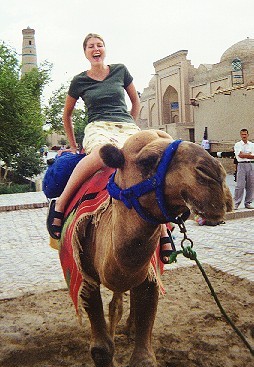





However there were periods when camels in Khiva were appreciated for more than their pictorial qualities. In ancient times camels were revered as the symbol of the mighty Zoroastrian war god, Veretdagna. Worshippers sang a special hymn and made small terracotta camels that are still manufactured for tourists today. Camels continued to play an important part in daily life right up until the turn of the twentieth century when around 130 000 camels inhabited Khorezm. Most of them belonged to the Turkomans who used to mate dromedaries with bactrians to produce a crossbreed with one extra long hump. The camels were used for everything from transporting people and goods to powering oil presses and irrigation devices. The thrifty Turkoman tribes also used them to produce milk, meat, wool and leather, and even kept their bones for building houses.
Whilst many tourists see the twenty-year-old Micha as a showpiece icon of the Silk Road, local people still carry on the traditions of their ancestors and pay good money for his wool, saliva, urine and dung. The camel's portly owner is the first to extol the surprising medicinal virtues of his phlegmatic beast. Belts made from camel hair are worn under clothing by those suffering from kidney stones and reputedly rid the body of the stones within six months to a year. Camel saliva and urine are thought to be very good for killing feet fungus and rubbing on arthritic joints, whilst a balm of effervescing camel saliva is said to cure the skin of unsightly blemishes. Camel teeth ward off misfortune and are sometimes worn as pendants or hung above car dashboards. A clump of camel wool held in the hand will aid a woman giving birth and a twist of camel wool worn by a nursing mother will protect her mammary glands from infection and safeguard her baby from the 'evil eye'.
People in Khorezm do not eat camel meat; the camel being the preferred transport of the prophet Mohammed and therefore considered holy. However in neighbouring Bukhara, Turkmenistan and Karakalpakstan the locals have no such compunction. In fact Bukharans believe that camel meat should be cooked at least once a year to ensure that the family pot will remain bounteous and full.
Yet camel meat also has its drawbacks. Khivans believe that if a pregnant woman eats camel meat, her baby will stay in the womb for ten months rather than nine. This unpleasant condition can only be remedied by walking around the camel three times and then crawling between its legs. This procedure has an even more dramatic effect on women who have not eaten camel meat during their pregnancy; they give birth within three days. Yet another part of the camel is used to ensure an easy delivery. Small dried balls of dung are burnt underneath the expectant mother's legs and as the smoke wafts around her she will rapidly give birth.



